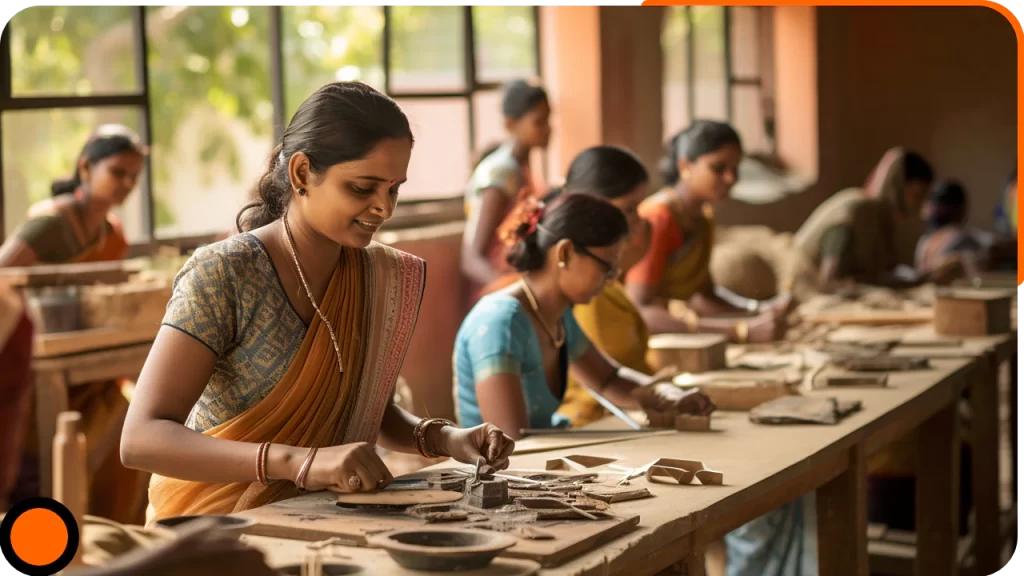TATA Communications
Women Livelihood
Partner/Client
TATA Communications
Sector
Women Livelihood
Location
Jharkhand and Odisha
KEY HIGHLIGHTS
- Trickle Up launched the MPOWERED (Mobile Connections to Promote Economic Development of Women) project in 2016 with Tata Communications and the state branches of the National Rural Livelihoods Mission in Odisha and Jharkhand.
- TATA Communications partnered with 4th Wheel to conduct an impact assessment between January 2024 and March 2024 in two districts of Jharkhand and Odisha. This project involved a social return on investment (SROI) analysis to quantify the initiative’s impacts and changes. The objective was to convert these outcomes into measurable figures to determine the social value generated for each Indian rupee (INR) invested.
APPROACH
Graduation Approach Utilization: The project applied Trickle Up’s Graduation Approach to foster sustainable livelihoods, placing mobile technology directly into the hands of women struggling with extreme poverty and vulnerability. This method combined participant selection, livelihood planning, market research, training, coaching, and savings strategies to build a comprehensive support system for overcoming poverty.
Provision of Empowerment Tools: The program provided smart sakhis (community facilitators), mobile phones, connections to self-help groups, smart cook stoves, grants or seed funding, livelihood training, links to government programs and schemes, and relief materials during the COVID-19 pandemic.
Objective of the Study: The aim was to quantify the project’s impacts and changes in tangible terms to assess the social value generated for each Indian rupee invested.
Scope of Participation and Location: The study intended to capture a wide demographic. It included 350 women from 27 villages across Odisha and Jharkhand.
Data Collection Methods: Data collection was undertaken using structured interviews with women participants, focus group discussions (FGDs), smart sakhis, the implementation team, and government officials.
Sampling Techniques: The research used proportionate sampling to select cohorts, stratified sampling to select blocks, and purposive sampling to select specific gram panchayats and villages.
INSIGHTS AND FINDINGS
Social Return on Investment (SROI): The SROI ratio achieved is 1:10.60, indicating a significant return of INR 10.60 for every rupee invested.
Agricultural Advancements: The program successfully promoted advanced agricultural practices. It focused on natural organic farming and crop diversification. Notably, over 70% of participants have now transitioned to vegetable cultivation.
Income Growth: There has been a notable increase in household incomes. In Jharkhand, average incomes rose from INR 41,168 to INR 70,718, and in Odisha, from INR 30,742 to INR 45,451. These figures demonstrate an enhanced financial stability through the program’s interventions.
Financial Inclusion and Community Engagement: The initiative increased women’s bank account ownership and engagement in Self-Help Groups (SHGs). This financial inclusion fostered greater community involvement and financial independence.
Nutritional and Skills Training: Participants received training on cultivating vegetables and fruits in Nutri gardens to increase nutritional values and support a balanced diet. Training also extended to agriculture, livestock rearing, and trade skills such as broom making and vermicomposting. The capacity development that happened via these trainings equipped women to initiate small-scale businesses and sustainable livelihoods.
Seed Grant Assistance: Seed grants were provided to support women in bettering their agricultural activities. While some participants utilized these funds for further agricultural ventures, others invested in livestock, diversifying their sources of income.
RECOMMENDATIONS/VALUE ADDITION
Collaboration and Government Support: Establish collaborative formal partnerships with relevant government agencies such as horticulturists, agriculturists, veterinarians, and forestry departments to align program objectives with government priorities. Organize regular exposure visits for participants to successful agricultural and livestock interventions to share best practices and facilitate improved livelihood intervention uptake.
Financial Support and Grants: Advocate for increased seed grants and funding allocations to empower participants and expand business opportunities. Facilitate access to subsidies and financial assistance programs for agriculture, livestock, and small business development through collaboration with government agencies and financial institutions.
Training and Skill Enhancement: Develop structured training programs tailored to participants’ needs, covering agriculture techniques, livestock care, forestry management, entrepreneurship skills, and market linkages. Invite subject matter experts to conduct specialized workshops and hands-on training sessions on topics like Nutri-garden farming, mushroom cultivation, vermicomposting, and small business management.
Access to New Markets: Develop strategies to enhance market access for participants through branding initiatives, product differentiation, and partnerships with retailers, wholesalers, and e-commerce platforms, especially for livestock and micro-enterprise-related activities. Create more opportunities to access local and regional markets to widen distribution channels and increase sales.
Technology and Digital Tools: Upgrade the program’s mobile application by incorporating user-friendly features and multimedia content such as video tutorials and expert interviews. Provide training on digital literacy for effective utilization of digital tools for learning, communication, and business operations.
21st Century Skills: Provide specialized training sessions focusing on critical thinking, problem-solving, and digital literacy to equip women participants with the skills necessary for success in their livelihoods.
Program Design and Duration: Extend the program to five years for a more gradual and sustainable approach to skill development and economic empowerment. Provide transportation support to overcome barriers to participation and ensure regular attendance at training sessions and market events. Allocate additional human resources to support program expansion as well as monitoring and evaluation for efficient program delivery.

